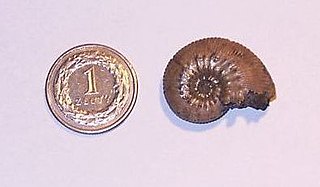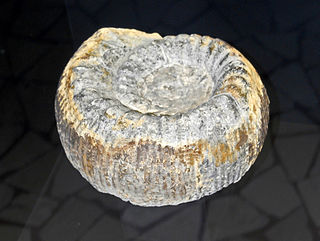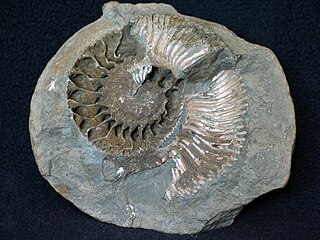Balticeras is an involute, discoidal Upper Jurassic (Oxfordian) ammonite found in England, Germany, and Switzerland, belonging to the Perisphinctidae. The shell is strongly embracing, tending to be oxyconic. Sides are gently curved, converging on a narrow to sharp ventral rim.
Unipeltoceras is an extinct ammonite genus included in the perisphictacian family, Aspidoceratidae, and a member of the subfamily Peltoceratinae, that lived during the Callovian stage, late in the Middle Jurassic.

Ammonitina comprises a diverse suborder of ammonite cephalopods that lived during the Jurassic and Cretaceous periods of the Mesozoic Era. They are excellent index fossils, and it is often possible to link the rock layer in which they are found to specific geological time periods.

Kosmoceras is a moderately evolute ammonite genus from the upper Callovian of Europe with a simple aperture and irregular ribbing interrupted by an irregular row of lateral tubercles. Strong ventral tubercles are separated by a smooth depression running along the rim.
Dorsetensia is a narrowly coiled discoidal ammonite from the early Middle Jurassic, lower Bajocian, belonging to the family Sonniniidae of the superfamily Hildoceratoidea. The inner whorls are ribbed or smooth, outer whorl is smooth. The outer rim (venter) is narrow, with a keel running along the middle. The umbilicus, the opening in the middle of the shell exposing inner whorls, is of moderate size with a sharp, sometimes undercut edge.
Tithonoceras is a genus of nautiloid cephalopod from the Upper Jurassic found in the Crimea, belonging to the nautilacean family Paracenoceratidae.

Peltoceras is an extinct ammonite genus from the aspidoceratid subfamily Peltoceratinae that lived during the later part of the Middle Jurassic.
Syringonautilidae is a family of Nautiloidea from the middle to late Triassic. Syringonautilidae comprise the last of the Trigonoceratoidea and are the source for the Nautilaceae which continued the Nautiloidea through the Mesozoic and into the Cenozoic right down to the recent. Syringonautilidae is a strictly Triassic family, derived early in the Triassic from the Grypoceratidae.

Grypoceratidae is the longest-lived family of the Trigonoceratoidea, or of the near equivalent Centroceratina; members of the Nautilida from the Upper Paleozoic and Triassic.

Stephanoceratidae is a family of planulate and coronate ammonites within the Stephanoceratoidea. Shells are evolute so that all whorls are exposed and have strong ribbing that bifurcates, that is splits in two, on the flanks. Many have tubercles at the point of bifurcation. Whorl sections are generally subequant; the outer rim, or venter, commonly rounded.

Macrocephalites is a genus of the stephanoceratoid ammonite family Macrocephalitidae, diagnostic of the Callovian stage of the Middle Jurassic. Three subgenera, Dolikephalites, Kamptokephalites, and Pleurocephalites are recognized in addition to Macrocephalites itself, with Indocephalites tentatively included as the fourth.

Perisphinctoidea, formerly Perisphinctaceae, is a superfamily of Middle Jurassic (Bajocian) to Lower Cretaceous (Barremian) ammonites, commonly with evolute shells with strong ribbing that typically divides about mid flank before crossing the venter.
Pachyceratidae is a family of Perisphinctoidean ammonites from the upper Middle - and lower Upper Jurassic. Genera within the Pachyceratidae have shells that are in general moderately involte but with most of the inner whorls exposed; whorl sections subquadrate to subtrapezoidal, with rounded venter. Ribbing is strong, in some sharp. Primary ribs typically branch above mid flanks into twos, threes, and even fours.
Crucilobiceras is an ammonoid cephalopod genus from the Lower Jurassic belonging to the eoderoceratoidean family Eoderoceratidae. Cruciliboceras has an evolute shell, such that all whorls are well exposed, with persistent radial ribbing and with spines or tubercles on the outer, ventral, rim, and in some, tubercles in the inner, umbilical, rim. The genus Crucilobiceras is commonly found along the Jurassic Coast of England.

Distichoceras is a member of the Haploceratacean family, Oppeliidae, and type genus for the subfamily Distichoceratinae, found in upper Middle and lower Upper Jurassic sediments in Europe, Algeria, India, and Madagascar. The shell is essentially evolute and compressed with the outer flanks converging on a narrow, keeled venter; inner flanks which may be feebly ribbed, are separated from outer by a shallow spiral groove or band. Ribs on outer flanks end on or are looped to tall clavi that line the venter, standing above the keel.
Flabellisphinctes is small, evolute ammonite genus from the upper Middle Jurassic (Callovian) that lived between 160 and 154 Ma ago.
Hecticoceratinae is a subfamily of oppeliids from the Middle and Upper Jurassic typically with strong falcoid or falcate ribbing that covers whorl sides completely. Venters are usually keeled and may be tricarinate.
Ochetoceras is a genus of ammonites, belonging to the Oppeliidae, that lived during the Late Jurassic from the early Oxfordian to the early Tithonian, and type for the subfamily Ochetoceratinae.

Quenstedtoceras is a genus of ammonoid cephalopods that lived during the latter part of the Jurassic period in what is now France, Poland, Germany, and the United Kingdom.

Cleviceras is an extinct genus of cephalopod belonging to the family Hildoceratidae. These cephalopods existed in the Jurassic period, during Toarcian and possibly even uppermost Pliensbachian age. Sometimes, it is considered to be a synonym of Eleganticeras.










